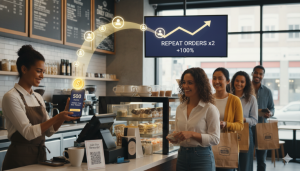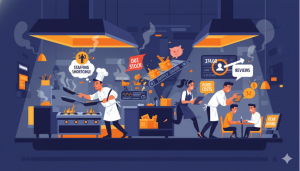Any food business knows how crucial food delivery and online ordering are in today’s digitized world. The pandemic accelerated and solidified this trend, turning food delivery into a part of customer’s daily lives and food businesses’ regular operations.
Today, 53% of adults say takeout and delivery are essential needs. If you want your food business to thrive, food delivery must become a key strategy. And along with that, customer experience when having food delivered should too. This article dives into how you can enhance your customer experience for food delivery.
Why Is Good Customer Service Important in Food Delivery?
Food delivery has now become a norm in today’s food industry. With the surge of food ordering apps and online ordering systems, it’s now easier than ever to have food delivered directly to your doorstep.
But as technology has advanced, so have customer expectations. So, why is good customer service crucial in food delivery? Here are a few reasons why:
Fosters Loyalty and Repeat Business
81% of people claim that good customer service makes them more likely to make another purchase. It’s not just about the food but the entire experience. When customers feel valued and well-served, they’re more likely to reorder from the same service and recommend it to friends and family.
The food industry brims with competition within their local areas. Earning customer loyalty through excellent service can be a defining edge.
Addresses and Rectifies Issues Promptly
Even the best food ordering apps can encounter technical problems, whether glitches in the online ordering system or mix-ups in the delivery process. Good customer service ensures we can address these issues when these issues arise. As a result, customers get what they ordered with little to no hassle.
Enhances Brand Reputation
Word of mouth can make or break a business, especially in today’s digital era. Positive reviews, testimonials, and social media shoutouts can significantly boost a brand’s reputation. Conversely, a single negative experience can lead to damaging feedback that spreads like wildfire. Food businesses should prioritize good customer service to improve or maintain a positive brand reputation.
Builds Trust with Customers
Trust is paramount in the food industry, especially to build a loyal customer base. When having food delivered, your guests and clients must feel confident that their orders will arrive on time, as described, and in perfect condition.
Offering reliable and responsive customer service lets food delivery platforms build and nurture this trust and assure customers of their credibility.
Adapts to Changing Customer Needs
The food delivery landscape is continually evolving, and so are customer preferences. Good customer service doesn’t just react to issues; it proactively seeks feedback and makes improvements.
Feedback and social listening mark customer experiences and quality customer service. When you take customer feedback and adjust accordingly, you best stay in tune with customers’ expectations. This way, your business can innovate and adapt to ensure you remain relevant and in demand.
9 Tips to Improve Customer Service in Food Delivery
The food delivery industry is thriving, and with the rise of numerous competitors, standing out becomes more challenging. At the heart of differentiating your business lies impeccable customer service. Here are nine tips to refine and uplift your food delivery customer service:
1. Invest in Skilled Communication Staff
In the vast realm of customer service, effective communication reigns supreme. Consider hiring individuals with a degree in communications. These professionals are trained to handle conversations tactfully, empathetically, and clearly. They can navigate complex situations, ensuring customers always feel heard and valued.
If hiring new personnel isn’t feasible, consider providing communication training to your existing staff, highlighting the principles typically covered in communication degrees.
2. Embrace the Power of E-commerce Chatbots
The modern customer values instant responses. Incorporating an e-commerce chatbot into your service platform can transform the user experience. These chatbots can address many common queries, from order status checks to menu inquiries.
By offering immediate answers, you reduce customer wait time and free your human agents to handle more complex issues. Moreover, chatbots can operate round-the-clock, addressing customer concerns outside business hours.
3. Re-evaluate Your Restaurant Menu Pricing Strategy
Pricing plays a pivotal role in customer perception. An effective restaurant menu pricing strategy ensures you balance profitability and customer satisfaction. Regularly reviewing and adjusting your pricing in line with market trends, customer feedback, and internal costs can foster trust.
Customers appreciate transparency and fairness in pricing, and they’re more likely to become repeat patrons if they perceive value in their purchases. Work your delivery fee into orders if they reach a minimum basket size.
4. Comprehensive Training is Key
The food delivery world constantly meets constant innovations and shifts in customer preferences. Providing continuous training sessions for your team can keep them abreast of industry best practices.
Training should cover various soft and hard skills. Some common training points include:
- Handling challenging situations
- Understanding the nuances of the delivery process
- Leveraging tools like food delivery apps, inventory systems, and order management software.
5. Champion Transparency
Problems and issues are bound to happen when delivering food to a customer, whether it’s a delay due to traffic congestion or an error in the order. Accordingly, you should find means and ways to keep customers in the loop. Proactively communicating issues and providing realistic solutions demonstrates respect for your customers’ time and trust.
6. Establish a Robust Feedback Mechanism
Active listening is a trait often emphasized by highly successful restaurants and food businesses. Applying this principle, you should create a system encouraging customers to share positive and critical feedback.
This does more than provide insights into areas for improvement. It also conveys to customers that their opinions are valued. Often, a customer’s insights and ideas can give you innovative ideas to improve your customer experience or business.
7. Personalize the Experience
Personal touches make a massive difference in a service-based business. Simple gestures, such as addressing customers by name or remembering past orders, can foster loyalty. Moreover, you can launch personalized marketing campaigns using email marketing or SMS software. Use your customers’ individual preferences and order history to enhance customer engagement.
8. Stay Updated with Technology
Technology is revolutionizing the food delivery industry. You now have easy access to advanced online ordering systems, AI-driven chatbots, and other tools to help you streamline your operation and improve the customer experience.
Stay updated with the latest tech trends, as this can significantly enhance your company’s customer service if you leverage the tools well. For instance, consider transitioning to an automated online ordering system if you’re still grappling with manual order entries. Such systems reduce errors, speed up the process, and offer a more seamless experience to customers.
9. Prioritize Problem Resolution
Teach your team how to handle problems when they arise internally as well. The food industry is quick, so adaptability and quick thinking matter massively. You should have systems in place to deal with these urgencies. But sometimes, there will be issues beyond the standard operating procedures.
Training a dedicated problem-resolution team or a well-defined escalation process can ensure customer grievances are addressed promptly and satisfactorily. Hire or upskill a store manager to address these operational problems for smaller restaurants and businesses.
Online Tools to Improve Your Food Delivery Customer Experience
Let’s delve into some of the top online tools that can enhance your food delivery service:
- Chatbots and AI Assistants – Chatbots, powered by artificial intelligence, can handle many customer queries in real time. From order status checks to menu explanations, these bots provide instant support, ensuring customers never feel left in the dark. Plus, they can operate 24/7, offering assistance even during off-hours.
- Route Optimization Software – Timely delivery is a significant aspect of the food delivery experience. Route optimization tools utilize real-time traffic data to provide the quickest routes for your delivery personnel. This ensures food reaches customers hot and fresh, reducing fuel costs and delivery times.
- Feedback and Survey Platforms – Understanding customer sentiments is pivotal for improvement. Tools like SurveyMonkey or Typeform can help gather customer feedback effortlessly. By collating this data, businesses can gain insights into areas of enhancement and make data-driven decisions.
- CRM Systems – Customer relationship management (CRM) systems can track customer interactions, order histories, and preferences. Such insights allow businesses to personalize the customer experience, from marketing campaigns to tailored menu recommendations.
- Online Payment Gateways – A smooth payment process is crucial for a satisfactory ordering experience. Integrating trusted payment gateways like Stripe, PayPal, or Square ensures secure and seamless transactions, fostering customer trust.
- Push Notification Tools – Keeping customers informed about their order status, promotions, or new menu additions can enhance engagement. Push notification tools allow businesses to send real-time updates directly to customers’ devices.
- Loyalty Program Software – Rewarding repeat customers fosters loyalty and encourages frequent orders. These platforms can help businesses create and manage loyalty programs, offering regular patron discounts, points, or exclusive deals.
- Interactive Menu Designers – A visually appealing menu can enhance customers’ ordering experience. Many tools provide easy-to-use interfaces to design dynamic and attractive menus with images, descriptions, and pricing. Some great ones to check out are tools like Canva or Adobe Spark.
Conclusion
The essence of stellar customer service in food delivery lies in blending technology with a human touch. You can leverage e-commerce chatbots, regularly review strategies, and invest in skilled communication professionals. But the main goal is to find a way to set yourself apart in this competitive landscape.










